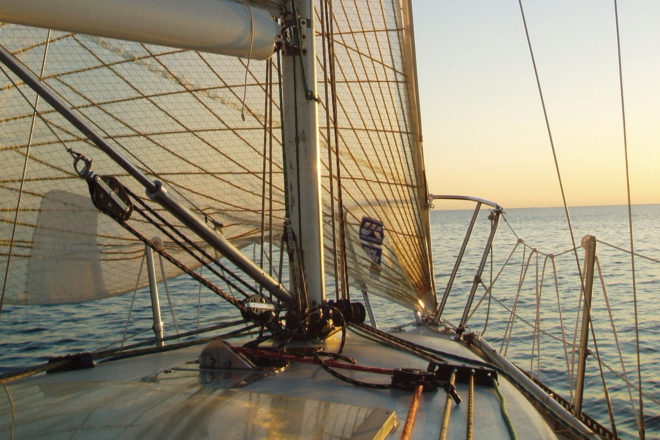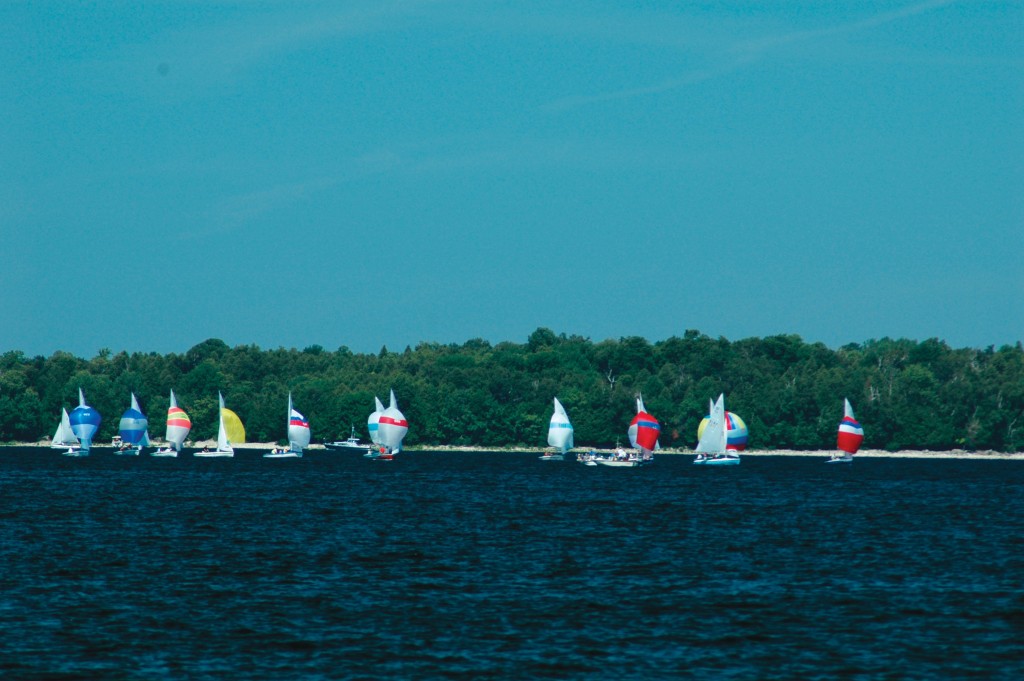Taking the Plunge: Choosing the sailboat for you
- Share
- Tweet
- Pin
- Share

Another summer day culminates in the sun sinking over the bay. The setting sun is framed by cumulus, birds in flight, and softer tones of an evening beginning to awake. Sails, too, are on the horizon, seemingly the only human element that could complement the tranquility of twilight – a piece of perfection in your mind’s eye. For most there could be no want for the moment, no improving on the experience.
Yet there are a growing number of people trading in their beach chairs for the experience of trimming these sunset sails, a chance at the helm of their very own sailboat. After all, sunsets are just as pretty from the deck of your boat as they are from the shore; some would say even better. Both landlubbers and novice sailors alike are taking the plunge into boat ownership and the rewards and challenges that come with it.
If you’re contemplating becoming your own captain, there are a few considerations. It is wisely and widely known that the sea is no place for the inexperienced. Fair enough, but we all need to start somewhere. Deb Duren of Yacht Works says, “The most important factor in first boat ownership is sailing lessons.” Too often this simple and seemingly obvious element is overlooked before the purchase of a sailboat.
Rick Wylie, co-owner of the Ephraim Sailing Center, echoes this view for new sailors. “My rule of thumb for boating is: don’t buy anything you haven’t sailed. You should have practical experience before purchasing a boat,” he says. A great way to determine if a boat is right for you is to simply take one for a spin. Wylie’s organization, operating out of both South Shore Pier and Nicolet Beach in Peninsula State Park, allows new sailors to do just that by renting either a Precision 15, a similar-sized Hunter, or a new kayak/sailboat hybrid. Over the years, they have also made their used boats available for purchase each fall.
Whether you wish to own a boat – small or large – the ideal vessel to learn on is the smallest. The real importance in mastering sailing on a smaller boat comes in the knowledge gained from your own weight placement, helmsmanship, and sail trim. Attempting to learn on a large boat is like trying to ascertain the nuances of flying a 747 instead of a small single prop plane. This can’t be underscored enough for those seeking to become proficient sailors.
For those who have paid their dues through sailing lessons or as amateur racing crew, your work has been done. Now comes the pleasure of kicking keels in parking lots and shuffling down docks in search of your perfect first boat. The first factor in your quest should frame your search. Determine what you seek to do with your boat. For example, how far do you see sailing alone or with friends and family? Duren suggests not crossing Lake Michigan on anything less than 30 feet. Theoretically, a wave on Lake Michigan can reach 36 feet; perhaps Duren’s advice should be heeded. But for those not seeking to cross our big pond right away, a smaller sailing dinghy could be a great start. A sailing dinghy is an open boat with a centerboard that does not typically have ballast to keep the boat from capsizing. Sailing dinghies are affordable, fun for most members of the family, and make great starter boats.

For limber adults and children growing their skill sets, the Walker Bay sailing dinghy is what Duren recommends. She points out that not only is the Walker Bay affordable, it also has more sail area for a high performance sail or a day with lighter wind. This also will make a great dinghy for shore access during extensive cruising on a larger sailboat because it can be rowed. In addition, Yacht Works carries the Sunfish, a popular 13-foot sailboat with an active nationwide fleet for both racing and day sailing. Unlike the Walker Bay, this boat cannot be rowed, only paddled in the case of a fading breeze. It is more similar to a small surfboard: wet, fun and seemingly indestructible.
The Walker Bay and Sunfish brands represent just the tip of the iceberg. When it comes to purchasing a boat, it is truly a buyer’s market. There are hundreds of sailing dinghy models and name brands out there. For resale purposes, it is a good idea to stick with a boat that has an active fleet. Another widely-used boat to consider is a single-handed sailing dinghy called a Laser. This Olympic-class boat is a bit bigger than a Sunfish, surfs more readily on waves, and is raced collegiately. Trailerablity is common to virtually all sailing dinghies and many, such as the Sunfish and Laser, can even be car-topped.
Yet another common boat in this class is the Flying Scott. Both the Ephraim Yacht Club and the Sturgeon Bay Sail Training Foundation make these 19-foot daysailers available. These boats have an added feature of extra room forward of the mast allowing for gear storage and crude shelter from rain.
Rick Langdon, an avid Door County sailor who has moved up from a 23-foot Pearson to a 34-foot racer-cruiser, says, “A person should start with a trailerable boat for convenience of storage and to keep costs down.” Smaller boats will cost less to maintain because they can be stored in a backyard or garage. If these boats have a motor it is typically an outboard, which can be easily winterized and stored away in a basement. So, for affordability, make sure you can take your boat home.
Langdon notes that the benefits of upgrading to a larger boat, once the owner is ready, are greater comfort with standing headroom and more spacious accommodations. Also apparent is the handling in rougher seas; heavier boats with longer waterlines perform better when the breeze is up. And though this may be an obvious factor, the downside, Langdon adds, is that larger boats are less maneuverable within the confines of a marina.
Tim Leonard, a veteran of the University of Wisconsin-Green Bay sailing team, has gone through a similar transition of purchasing more waterline. Leonard, a seasoned dinghy sailor, took a step from his 19-foot Lightning into a Rodgers 26 and offers some advice for prospective boat owners. He highly recommends spending ample time on the internet because it is a perfect way to research the pros and cons of similar boats. Design reviews and test sail commentary, as well as unique features and flaws, are commonly spelled out for most brokered boats.
For those who are willing to take the deep plunge into extensive cruising and/or racing, your search will begin with a larger boat. Once you’ve determined the size to accommodate your needs, your search can be narrowed. If you think you have found the perfect boat, pass the rose-colored glasses to other family members so they, too, can picture themselves in this newfound lap of luxury. If the excitement is as high as the fear, then it’s probably time to consider a purchase. Before signing on the dotted line, especially with larger boats, get your dream surveyed by a professional surveyor. Your insurance company will most likely need this document anyway and you will be better off making your purchase with a professional’s objective opinion. This may be the best money spent on your new floating adventure.
Too often, inexperienced sailors will buy the biggest boat that they can afford. This is usually a mistake. Keep in mind that although you now have a stable platform from which to operate, you also have large amounts of sail area, an inboard engine (which will fail eventually), and a myriad of mechanical systems. The chunk of lead we know as an inboard diesel engine will not only require a working knowledge of its mechanics, but will also utilize raw water coming through a hole in your boat. There will be a lot of holes in your boat below the waterline allowing for the intake and outflow of water for the engine and various systems. This factor alone makes the maintenance and inspection of your boat a more serious and rigorous process than that with smaller sailing dinghies.
For the mechanically-minded, these challenges may not only pique an interest, but may even be enjoyable. Do-it-yourselfers within the boating world form a large and serious cult of their own. There is even a periodical with just that name, DIY Boat Owner: The Marine Maintenance Magazine, with a wealth of information for just such boating enthusiasts.

For those who still insist on the amenities of a large boat but don’t want the bother of the maintenance, boatyards are happily standing by to take care of your every need though, of course, for a price. A good rule to keep in mind is that everything mechanical on your boat will eventually fail. When looking at older boats, particularly in age of 20 years or more, less is more. Electronics and gadgetry that are dated will most likely need replacing in the near future. Avoid older boats that are “loaded” unless the equipment is recently installed and warranties still remain. The real find is an older boat with a dry hull and a deck that has been well maintained with the absence of complex systems like air conditioners, refrigerators or water makers. Chances are, anyway, if you need a whole lot of amenities in order to be comfortable, you won’t want to spend your vacation sailing.
The construction of older boats in many cases is superior to today’s construction where shortcuts have been taken to reduce cost. Today’s designs have changed to accommodate dockside entertaining over the concerns of proper sea keeping once offshore.
Old or new, take your time and choose wisely. If you have put your time in as a crew member and chosen a boat within your means and abilities, your time onboard will be spent underway instead of at the dock with the fearful and overworked. Take your time in your search, ask many questions, and get a professional survey. If boat ownership is achieved carefully, you, your family and friends will enjoy years of adventure, fun and excitement. Oh, and don’t forget to pull her seaward as the sun sets so the rest of us can enjoy the view too!


